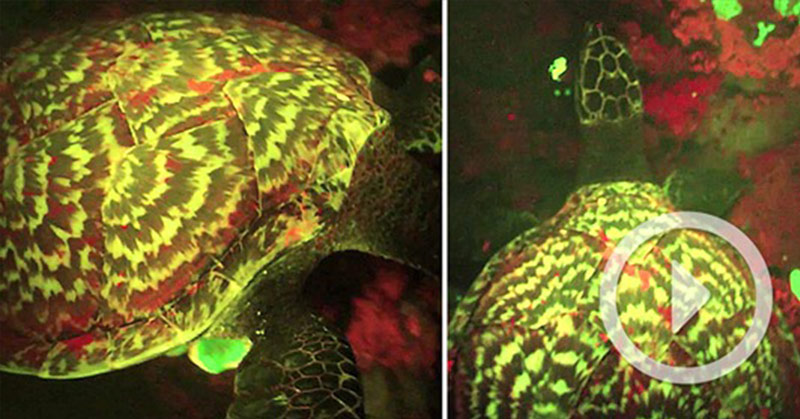If you have been paying attention to the news the past few years, you may have heard of the glowing sea turtle discovered by marine biologists during a diving trip in the South Pacific.
Although this turtle was discovered in 2015, biofluorescence—the scientific processes behind the turtle’s glow—has recently been growing in popularity has been trending online.
Here is everything you need to know about the glowing sea turtle and why their discovery could have a significant impact on biomedical research.
Discovery of the Glowing Sea Turtle
During a shark dive off the coast of the Soloman Islands in 2015, marine biologist David Gruber of the City University of New York made a baffling discovery: a sea turtle that glowed red and green. Gruber swam after this turtle until it dove out of sight, but was able to capture video footage. Upon watching the footage back, Gruber was able to recognize the species as a hawksbill sea turtle.
Excited by his discovery, Gruber traveled to a turtle farm near the Soloman Islands that hatched and raised young hawksbill turtles to prove that the glowing turtle he witnessed was not just an anomaly. When blue light was shed upon these young turtles they, indeed, glowed green.
Although marine biologists had previously observed a number of species that exhibited a similar glow, such as certain types of algae, the glowing turtle sparked a new and increased degree of attention to the scientific processes of biofluorescence and bioluminescence.
The Hawksbill Sea Turtle
This ‘glowing sea turtle’ that Gruber discovered is not a new species; rather, it is a nickname given to the rare and endangered hawksbill turtle based on its newly discovered ability to biofluoresce.
According to the National Oceanic and Atmospheric Administration, hawksbill sea turtles are a rare and endangered species of sea turtle that are most commonly found in the tropical waters of the Atlantic, Pacific, and Indian Oceans. These turtles spend most of their time near coral reefs that are home to their preferred food—sea sponges. However, the rapid loss of coral reef habitats has proved to be a significant threat to this species’ vitality.
Similar to other species of sea turtles like the loggerhead, hawksbill turtles will often travel long distances between their nesting beaches and coral reef feeding grounds. They have even been known to travel distances of over 1,000 miles between these locations.
Although their exact life expectancy is unknown, hawksbill turtles are thought to live very long lives, reaching sexual maturity around the age of 25. Once it has reached maturity, female hawksbill turtles will travel to nesting beaches three to five times every couple of years to lay its eggs. Shockingly, each nest contains between 130 to 160 eggs, meaning a female will lay up to several thousand eggs during its lifetime! Unfortunately, though, a very small percentage of these eggs will hatch and live to adulthood due to a high number of predators and human disruption of nests.
The hawksbill turtle is named after the shape of its jaw, which comes to a sharp V-shape at its end, making these turtles’ jaw and mouth look similar to the beak of a bird. The sharpness and shape of the beak allow these turtles to reach into small holes and crevices in coral reefs to forage for food.
Aside from the shape of their jaw, this species of turtle is best recognized for its beautifully patterned, amber-colored shell; however, it is their beautiful shell that has caused this species to become endangered. For several hundred years, the hawksbill turtle has been hunted and killed in massive numbers for the desired “tortoiseshell” pattern common in jewelry and other accessories and trinkets.
Read: Dozens of Creatures Thought to Be Extinct Found Alive in ‘Lost City’ in the Jungle
Why Do They Glow?
Although the hawksbill sea turtle may seem to be a relatively ordinary species of turtle, marine biologist David Gruber proved in 2015 that these turtles are far from ordinary. In fact, these turtles have a very unique trait: The ability to biofluoresce.
Biofluorescence, the scientific process behind the glow exhibited by the hawksbill turtle, is a natural process in which organisms absorb light of one intensity level and wavelength—or in simpler terms, the light of one color—and emit it at a different level and wavelength, or as a different color. In the ocean, creatures will absorb high-energy blue light and, as Gruber observed, emit such light in lower-energy shades of green, red, and orange.
This phenomenon is different, however than bioluminescence. Bioluminescence is a process in which organisms produce and emit their own light, versus absorbing and transforming light.
Discovery of biofluorescence in sea turtles was a shocking discovery, however, biofluorescence itself is not a new phenomenon. Scientists have been studying biofluorescence in organisms and plants for years. In fact, marine biologists have observed this scientific process in coral, jellyfish, and in over 180 species of marine fish including certain species of sharks and eels. It has also been observed in loggerhead turtles, another breed of sea turtle.
Researches who have studied biofluorescence suspect that it is the presence of fluorescent proteins in organisms that allow this process to occur. These proteins are said to be potentially monumental in cancer, brain, and other biomedical research, as they can be injected and used to track cellular functions and neural activity.
Summary
Although there is still much more research to be done, the discovery of biofluorescence in sea turtles suggests that there are perhaps many other species of reptiles that also exhibit this phenomenon. It’s possible, even, that more common species of turtles are able to biofluoresce. This discovery could provide scientists and researches with more opportunities to study why and how this process occurs as well as how useful these fluorescent proteins could be in biomedical research. However, because the hawksbill turtle is classified as endangered under the Endangered Species Act (ESA), swift action must be taken to protect this species in order to further study the prospects of biofluorescence.
Keep Reading: New Species of Turtle Discovered

